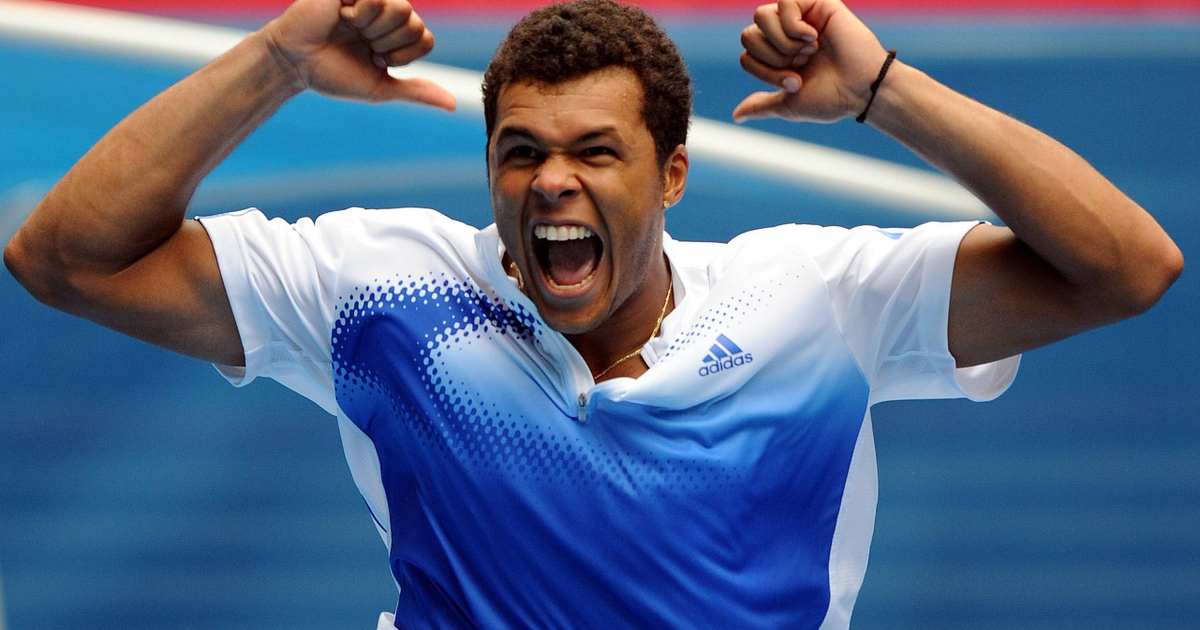A man of challenge, Jo-Wilfried Tsonga has, on many occasions, proven that he knows how to sublimate himself.
Close-up on his greatest hits.
A selection in which could have slipped the silver medal at the London Olympics (in doubles with Michaël Llodra) or victory in the Davis Cup final against Belgium in 2017 (after having been the centerpiece of the campaign, he had saw Lucas Pouille bring the point of victory).
Jo-Wilfried Tsonga (37 on April 17) will remain as the most regular Frenchman in the major tournaments of the Open era (one final, five semi-finals, nine quarter-finals).
He is one of the few players to have beaten all the members of the Big 4 (Djokovic, Federer, Nadal and Murray) in Grand Slams.
He won 19 ATP titles (only Yannick Noah 23 did better among French players),
including 2 Masters 1000, in Paris in 2008 (by dominating David Nalbandian in the final) and in Toronto in 2014 by chaining successes against Djokovic, Murray, Dimitrov and Federer in the final.
He was a finalist in the 2011 Masters (after beating Nadal in the pools).
He spent 260 weeks in the Top 10 and holds the record for a Frenchman for winning Grand Slam matches (121).
Whoever points to 220th in the world will participate in the Monte-Carlo tournament, from Sunday, then will play in Aix-en-Provence and Lyon, before sharing the last sequence at Roland-Garros.
A look back at the highlights of a rich career.
He was a finalist in the 2011 Masters (after beating Nadal in the pools).
He spent 260 weeks in the Top 10 and holds the record for a Frenchman for winning Grand Slam matches (121).
Whoever points to 220th in the world will participate in the Monte-Carlo tournament, from Sunday, then will play in Aix-en-Provence and Lyon, before sharing the last sequence at Roland-Garros.
A look back at the highlights of a rich career.
He was a finalist in the 2011 Masters (after beating Nadal in the pools).
He spent 260 weeks in the Top 10 and holds the record for a Frenchman for winning Grand Slam matches (121).
Whoever points to 220th in the world will participate in the Monte-Carlo tournament, from Sunday, then will play in Aix-en-Provence and Lyon, before sharing the last sequence at Roland-Garros.
A look back at the highlights of a rich career.
A boxer knocks out Nadal
January 2008, Australian Open semi-final 6-2, 6-3, 6-2 against Rafael Nadal (in 1h57).
38th at ATP, the French made the semi-final a recital.
Nadal's ball seems chloroformed, his game, his vivacity, his will are anesthetized by the force of percussion, the precision, the violence of Tsonga who makes the meeting a dream (85% of points scored on his 1st serve, 18 aces, 5 break points converted out of 7).
France discovers a tiger playing spectacularly, with a facetious, luminous smile.
The international press seizes the charismatic character, compares him to Mohamed Ali, he has fun.
Joy of living and playing (ready to swallow 200 places in the ATP ranking, from January 2007 to January 2008) communicative.
Demonstration.
Of strength, of audacity.
A tornado.
A delight.
The unprecedented winner of the final of the
The offense to the King
July 2011, quarter-finals at Wimbledon, 3-6, 6-7 (3), 6-4, 6-4, 6-4 against Roger Federer.
This is a first in Roger Federer's career.
The Swiss, a real computer, carefully cultivates the statistics that sculpt his legend.
Until this match, the Swiss had never let slip the gain of a meeting after pocketing the first two sets.
But Tsonga does not bother with the weight of the archives and the prestige of his rival.
He stops the race of the Swiss legend.
In his garden.
A revolution.
Roland-Garros at heart
June 2015, Roland-Garros quarter-finals, 6-1, 6-4, 4-6, 3-6, 6-3 against Kei Nishikori.
The comeback game.
After a well-controlled round of 16 against Tomas Berdych (6-3, 6-2, 6-7, 6-3), having in terms of movement and power recalled flashes forgotten since the Australian Open 2008 when he distilled his blows with rage and recklessness, walked his opponents, abandoned them groggy "Jo" erases with authority the obstacle represented by the seeded n°5 to invite himself into the last four at Roland-Garros.
Domination in two stages.
After the interruption of the game (37 minutes) following the fall of a 3 m long aluminum plate on a court platform.
At the height of emotion, like Gustavo Kuerten, he writes on earth "Roland, I love you".
Revenge against Djokovic
January 2010, Australian Open quarter-finals, 7-6 (8), 6-7 (5) 1-6, 6-3, 6-1 against Novak Djokovic.
The revenge (in 3h58) of the final of the Australian Open 2008 is scored after an intense showdown.
Tsonga slams 19 aces, converts 35 points out of 59 on the net, passes 73 winning shots for 55 unforced errors, roars, gives some spectacular scratches.
Melbourne succeeds him.
Like Djokovic.
The Frenchman shattered the predictions of Australian bookmakers.
The Birth of the Thumb Dance
January 2008, Australian Open first round, 7-5, 6-4, 0-6, 7-6 against Andy Murray.
Spin.
A final forehand from the Scotsman (seeded n°9, followed by Gasquet n°8, Youzhny n°14) escapes and Jo collapses.
Measuring the extent of the success, of the path traveled (after multiple injuries), of this tournament where his temperament is expressed (in 2007, he had snatched a tie-break from Roddick 20-18).
The thumb dance can begin.
She will carry it to the final.
And will be a celebration that will accompany him throughout his career…

